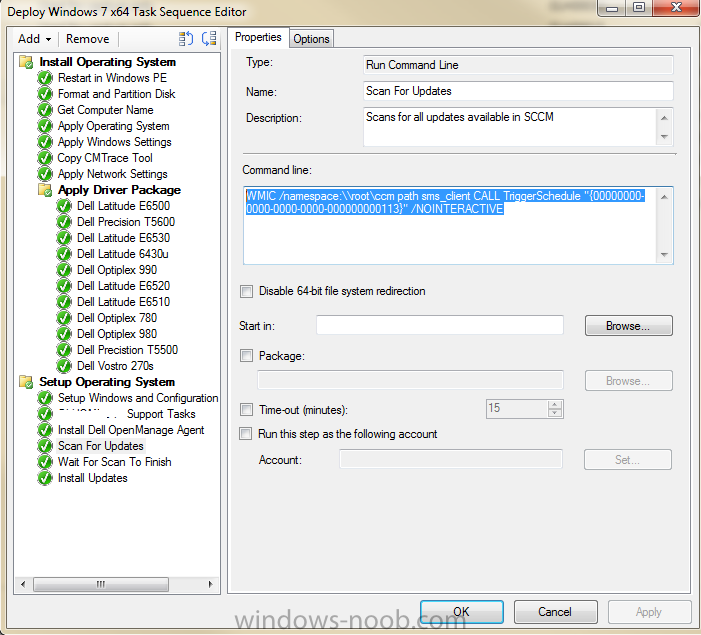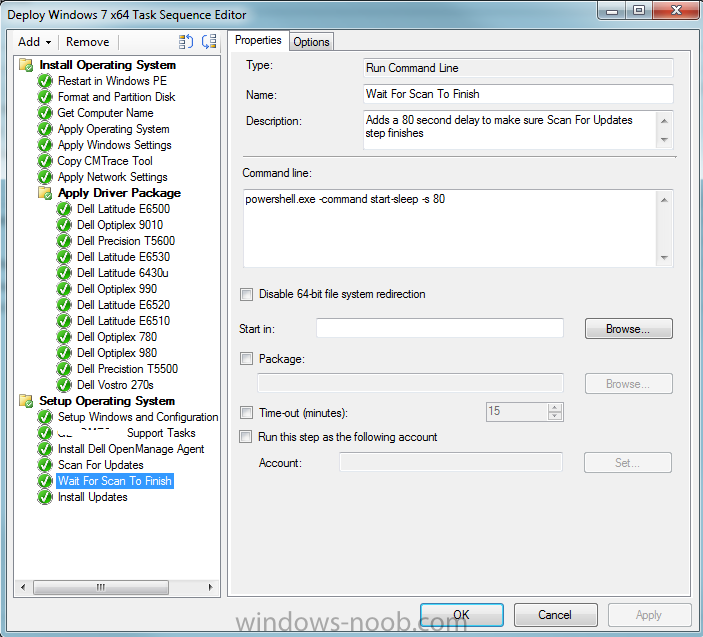
n00blar
Established Members-
Posts
74 -
Joined
-
Last visited
-
Days Won
2
n00blar last won the day on December 2 2011
n00blar had the most liked content!
About n00blar
- Birthday 03/04/1971
Profile Information
-
Gender
Male
-
Location
USA
n00blar's Achievements
Newbie (1/14)
2
Reputation
-
Sorry to resurrect this thread, but I have the exact same issue and I'm still unable to change cache size from within a task sequence. I know I can do it as a package, an app, etc, etc, but I want to do it as part of a task sequence. I even read a MS Blog that says that it's supposed to work using SMSCACHESIZE=10240 in Setup Windows and ConfigMgr section, but it just doesn't work. Has anyone been able to get this to work from a task sequence? Thanks!!
-
n00blar started following How can I easily prompt for a computer name in Configuration Manager 2012 , Change SMS Cache Size , Deploy Windows 2008 R2 using SCCM 2012 SP1 and 7 others
-
Deploy Windows 2008 R2 using SCCM 2012 SP1
n00blar replied to n00blar's topic in Configuration Manager 2012
Great! I think I'll use MDT in this case.- 2 replies
-
- windows 2008 R2
- OSD
-
(and 2 more)
Tagged with:
-
I was wondering if anyone had a link that explains how to deploy Windows 2008 R2 Server using SCCM 2012 SP1. I'd like to be able to install certain Windows 2008 R2 roles (file sharing, printing, dfs, etc) and features (branchcache, snmp, etc) with SCCM 2012. I've looked around, but mainly I find Windows 7 deployment. Thanks!
- 2 replies
-
- windows 2008 R2
- OSD
-
(and 2 more)
Tagged with:
-
Install Windows Updates Using Task Sequence
n00blar replied to n00blar's topic in Configuration Manager 2012
Yes, I did...and nothing.- 4 replies
-
- updates
- task sequence
-
(and 2 more)
Tagged with:
-
I'm running SCCM 2012 SP1 and here's what I'm trying to achieve. I'm trying to deploy Windows 7 x64 SP1 updates via the same task sequence that deploys the OS. What I've done: Task sequence works and it targets the All Unknown Computers device collection Created a Scan For Updates task Created a Wait For Scan To Finish task Created Install Updates task Created a Software Update Group that lists Windows 7 x-64 updates for the last 9 months Created a deployment task for step 5 that targets All Unknown Computers device collection Created a Deployment Package for step 5 Here's what happens: OS is deployed properly Updates don't seem to be installed Here are some warnings I read in the WUAHandler.log file: Unable to read existing WUA resultant policy. Error = 0x80070002. Seems Group Policy is not yet initialized because client is in provisioning mode, writing WSUS Server location in registry. Here are errors in the smsts.log file: (these seem to be new errors that come up after installing SP1, but I don't know if these are preventing the updates from installing) CryptProtectData failed TSManager 5/8/2013 12:06:55 PM 2828 (0x0B0C) DecryptString failed. 8007000d. TSManager 5/8/2013 12:06:55 PM 2828 (0x0B0C) CryptProtectData failed TSManager 5/8/2013 12:06:55 PM 2828 (0x0B0C) DecryptString failed. 80070057. TSManager 5/8/2013 12:06:55 PM 2828 (0x0B0C) Getting active request access handle TSManager 5/8/2013 12:06:55 PM 2828 (0x0B0C) Error opening HKEY_LOCAL_MACHINE\Software\Microsoft\SMS\Task Sequence. code 80070002 TSManager 5/8/2013 12:06:55 PM 2828 (0x0B0C) Error - could not get package and program IDs. code 80070002 TSManager 5/8/2013 12:06:55 PM 2828 (0x0B0C) Failed to open the task sequence key HKLM\Software\Microsoft\SMS\Task Sequence. Error code 0x80070002 TSManager 5/8/2013 12:06:56 PM 2828 (0x0B0C) I'm attaching some of the configuration settings I've created in the task sequence.
- 4 replies
-
- updates
- task sequence
-
(and 2 more)
Tagged with:
-
Not just another "how do I prompt for computer name" thread ;)
n00blar replied to h4x0r's topic in Configuration Manager 2012
I've also modified it to extract DELL's asset bios label, and I use that information for SCCM's variable. -
SCCM2012 Automatic Computername in OSD^
n00blar replied to easybernd's topic in Configuration Manager 2012
At my company I use DELL's asset label (not the asset tag) for the computer's account name in active directory. We set the asset label during our BIOS setup, and then my script extracts this value and assigns it to the SCCM variable for the computer name. If there is no asset label configure in BIOS, the entire process stops. -
Not just another "how do I prompt for computer name" thread ;)
n00blar replied to h4x0r's topic in Configuration Manager 2012
I did something like that in my environment, check out this link with what I did. -
Automatic User and Device Affinity Guide
n00blar replied to hypercube33's topic in Configuration Manager 2012
Question, what's the purpose for enabling audits for login events? How does that match with UDA? Just curious. -
Did you Update Distribution Points? Sounds like to made quite a few changes, try removing the drivers you loaded to the Boot Images and see if that works again. Another thing you can try is, go to the properties of the boot image, then go to Images tab and use Reload. This may help, but I'm not sure. I also have DELL machines, and I used DELL WinPE drivers, but I didn't use WAIK or any other application. I did it all via SCCM console with no issues.
-
On the client that fails during Win PE boot, try pressing F8 to open a command line. Then from the command line, make sure that you can access your network, also, try to copy the client log file to review it.
-
Silent install
n00blar replied to mr_sherief's question in Deploy software, applications and drivers
Sherief, This link will help you with Office 2010. Adobe is quite simple, go to ftp://ftp.adobe.com and download the MSIs for reader there; the same goes for flash. -
Great article. Question, what's the recommended way of creating an OS image? Is it this one (create an image with all business-like applications) or the one specified in Part 7 of the SCCM 2012 labs? If I use the captured image (Part 7 lab), I can install all my packaged applications as an OSD task. Later on, if need be, I can upgrade those deployed packaged applications. I'm wondering if I can, safely, upgrade applications that have been installed in the captured-media image?
-
Well, not exactly. Site name and server name are different, same goes for ip information, etc.



